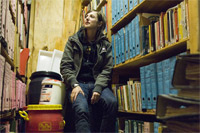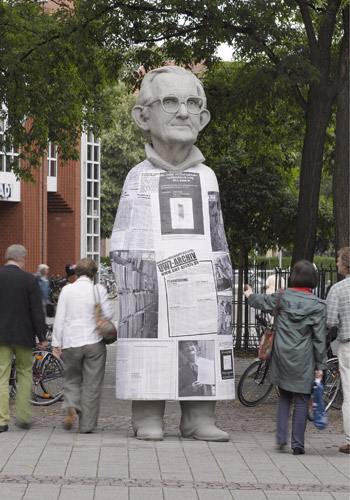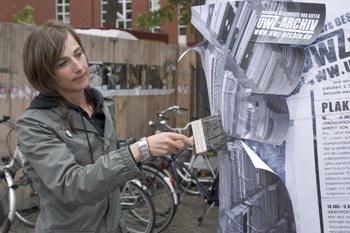news
newsletter
archive
imprint
PawelAlthamer | MichaelAsher | NairyBaghramian | GuyBen-Ner | GuillaumeBijl | MartinBoyce | Jeremy Deller | MichaelElmgreen und IngarDragset | Hans-PeterFeldmann | DoraGarcia |
IsaGenzken | DominiqueGonzalez-Foerster | TueGreenfort | DavidHammons | ValérieJouve | MikeKelley | Suchan Kinoshita | MarkoLehanka | GustavMetzger | EvaMeyer und EranSchaerf | DeimantasNarkevicius | BruceNauman | MariaPask |
ManfredPernice | SusanPhilipsz | MarthaRosler | ThomasSchütte | AndreasSiekmann | RosemarieTrockel | SilkeWagner | MarkWallinger | Clemens von Wedemeyer | AnnetteWehrmann | PaeWhite

*1968 in Göppingen, lives and works in Frankfurt

When he was seven, the miner’s son was put into a home because his parents’ apartment was too small for a family with four children. In 1932, he was moved to an asylum for the mentally ill. When his parents were finally able to take him back, he was declared mentally retarded, and, in March of 1938, he was sterilized against his will in the Paderborn State Hospital. It was the day after the Germans had annexed Austria. As Wulf himself described, “While everyone was shouting Sieg Heil, Sieg Heil, the annihilating knife was plunged into my body.” Paul Wulf was sixteen at the time. He was to live another sixty years. Since 1949, he fought legal battles against the Federal Republic of Germany, but to no avail. Paul Wulf, who despite his height walked with a stoop and appeared to be slight of build, could be seen in the streets of Münster carrying a heavy black briefcase filled with files and newspaper articles – documents pertaining to his struggles against fascism. He was a collector of stories that people would rather forget; he would randomly confront passers-by with the documents he carried in his briefcase and ask them questions they would never have asked themselves. Now, here he stands, three and half meters tall, as a memorial in front of the Stadthaus – a sculpture that also serves as an advertising column. It is as though the contents of his briefcase had spilled out onto his coat, creating a documentation of “Münster from below” – a chronicle of political events, of housing struggles, or of the anti-nuclear movement. With her project, for which the artist has collaborated with the Umwelt-Archiv-Verein Münster [Environment Archive Society], Silke Wagner has established a public forum for complex issues. The advertising column is only one part of the project; the archive is also being digitalized, and put in the Internet at www.uwz-archiv.de to make it accessible to a large audience.
Workmanship Sculpture: Herbert Rauer
Technical Support: Stephan Marienfeld
(www.uwz-archiv.de).
Contakt:
Umweltzentrum-Archiv
c/o Don Quijote
Scharnhorststr. 57
48151 Münster

Silke Wagner presents a broad range of forms and themes in her work. Still, her projects are based on a common principle: They explicitly refer to social, political, and ecological problems. Wagner co-operates with minority groups and initiates activities that underline publicly place into question and actively promote alteration of the situation. Her concept triggers a shift in the perception and impact of the objects, performances, and actions. The artist takes a clear political stand in her use of a minibus labelled "Lufthansa Deportation Class," provoking a national public debate about Lufthansa allowing its planes to be used for the deportation of refugees and when she provocatively appealed for couples to enter bogus marriages. But she also discusses the private level of representation, when she sparks rumours or develops a modular system, which can be used to build a piece of furniture that is functional or, if preferred, serves no purpose at all. Art serves both as a magic hat and as a tool.
Her works always trigger communication processes, offer a framework or a platform for social action. They also discuss the conditions of the art industry. "Locals only", and other projects, focus on the public space. Street skating is an example of how to appropriate and re-conquer outdoor venues.